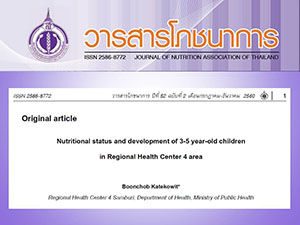Nutritional status and development of 3-5 year-old children in Regional Health Center 4 area
Keywords:
Children, Nutritional Status, Child DevelopmentAbstract
Preschool children are considered the important age group for country development in the future. Child care and feeding practice has the impact on nutritional status and child development, particularly during the period from maternal pregnancy through the children age of 6-years. The nutritional status and child development of 3-5 year-old children were studied in this research to determine maternal and child factors that were associated with child development. Three hundred and fifty preschool children were randomly recruited from child development centers located in 4 provinces. The child centers were under the supervision of the Department of Local Administration, Ministry of Interior. Body weight and height were measured in all children. Nutritional status was assessed using weight-for-age, height-for-age and weight-for-height indicators. The Denver II that covers 5 developmental areas as gross motor, fine motor, language and personal-social was the tools for assessment child growth and development. Results found that 16.6% of children were obese and 13.7% of children were underweight when assessed by weight-for-age. The prevalence of stunting, overweight and underweight with weight-for-height evaluation were 6.3%, 15.1%, 18.2% respectively. 71.4% of children were normal growth and development. In addition, the numbers of stunted children with the delayed development were found higher than the other groups. Logistic regression analysis indicated that factors that were associated with the delayed development of children were female children, low birth weight infant and the history illness of children. It was concluded that child growth and development in preschool children were still the public health problem in Regional Health Center 4 area. The monitoring of the nutritional status, child development and supporting of maternal health promotion since onset of pregnancy should be considerate as national policy.
References
2. สำนักงานสถิติแห่งชาติ, องค์การยูนิเซฟ, กระทรวงสาธารณสุข, สำนักงานหลักประกันสุขภาพแห่งชาติ, สำนักงานกองทุนสนับสนุนการสร้างเสริมสุขภาพและสำนักงานพัฒนานโยบายสุขภาพระหว่างประเทศ. การสำรวจสถานการณ์เด็กและสตรีในประเทศไทย พ.ศ. 2555 [อินเตอร์เน็ต]. 2556 [เข้าถึงเมื่อ 1 ตุลาคม 2560]. เข้าถึงได้จาก https://service.nso.go.th/nso/web/survey/surpop2-1-12.html.
3. สมศักดิ์ เลิศจีระจรัส. ความสัมพันธ์ระหว่างสภาวะฟันผุ กับภาวะโภชนาการและพัฒนาการในเด็กปฐมวัย. วารสารการส่งเสริมสุขภาพและอนามัยสิ่งแวดล้อม. 2550;1:34-47.
4. ชัยพร พรหมสิงห์, วรรณภา กางกั้น, พนิต โล่เสถียรกิจ. ภาวะโภชนาการเด็กปฐมวัยไทยพ.ศ. 2557.ชลบุรี: บางแสนการพิมพ์; 2559.
5. เยาวรัตน์ รัตน์นันต์. การศึกษาปัจจัยที่มีผลต่อพัฒนาการเด็กปฐมวัยไทย เขตสุขภาพที่ 8 [อินเตอร์เน็ต]. 2557 [เข้าถึงเมื่อ 1 ตุลาคม 2560]. เข้าถึงได้จากfile:///C:/Documents%20and%20Settings/admin/My%20Documents/Downloads/pdf-dcc759cb9a09c753df24f24460689ed9.pdf.
6. Kanjana A, Sarinya P, Sopawadee S. Associated of nutritional status and child development in Phrae Province [Internet]. 2006 [cited 2017 Oct 1]. Available from: https://www.pro.moph.go.th/doc_download/Files/paperk01.doc.
7. นพร อึ้งอาภรณ์. โครงการการศึกษาภาวะโภชนาการเด็กวัยก่อนเรียนในเขตพื้นที่รอบมหาวิทยาลัยเทคโนโลยีสุรนารี [อินเตอร์เน็ต]. 2556 [เข้าถึงเมื่อ1 ตุลาคม 2560]. เข้าถึงได้จาก https://sutir.sut.ac.th:8080/sutir/bitstream/123456789/5444/2/Fulltext.pdf.
8. นายแพทย์พนิต โล่เสถียรกิจ. สถานการณ์พัฒนาการเด็กปฐมวัย [อินเตอร์เน็ต]. 2558 [เข้าถึงเมื่อ1 ตุลาคม 2560]. เข้าถึงได้จาก https://hpc03.files.wordpress.com/2015/09/full-paper-childdev.pdf.
9. ลัดดา เหมาะสุวรรณ. โภชนาการกับการเจริญเติบโตสติปัญญาพัฒนาการภูมิต้านโรคและโรคเรื้อรัง. การประชุมเชิงปฏิบัติการร่วมใจสร้างเด็กไทยสูงสมส่วนสมองดีแข็งแรง; วันที่ 27 กุมภาพันธ์ 2556; ณ โรงแรมเอบีน่าเฮ้าส์ จังหวัดกรุงเทพมหานคร. กรุงเทพฯ: กระทรวงสาธารณสุข; 2556.
10. ดวงหทัย จันทร์เชื้อ, บุญสนอง ภิญโญ, ศุภสิทธิ์ พรรณารุโณทัย. ปัจจัยที่มีอิทธิพลต่อพัฒนาการเด็ก 0-5 ปี [อินเตอร์เน็ต]. 2547 [เข้าถึงเมื่อ1 ตุลาคม 2560]. เข้าถึงได้จาก: https://hpc2.anamai.moph.go.th/research/index.php/2551/58-0-5-2547.
11. Wayne WD. Biostatistics: A Foundation of Analysis in the Health Sciences. 6th ed. New York: John Wiley & Sons; 1995.
12. สำนักประเมินผลการจัดการศึกษาสำนักงานเลขาธิการสภาการศึกษา. รายงานความก้าวหน้าการจัดการเรียนรู้ระดับปฐมวัยปี 2551-2552. กรุงเทพฯ: เพลินสตูดิโอ; 2552.
13. ชลทิศ อุไรฤกษ์กุล. คำนวณภาวการณ์เจริญเติบโต [อินเตอร์เน็ต]. 2554 [เข้าถึงเมื่อ 1 พฤษภาคม 2560]. เข้าถึงได้จาก: https://hpe4.anamai.moph.go.th/Surveillance/growth.php.
14. วิษณุ คุณากรธำรง. ภาวะโภชนาการเด็กปฐมวัยในเขตสุขภาพที่ 6 [อินเตอร์เน็ต]. 2558 [เข้าถึงเมื่อ 1 ตุลาคม 2560]. เข้าถึงได้จาก: https://hpc6.anamai.moph.go.th/images/research/warisa250759.pdf.

Downloads
Published
How to Cite
Issue
Section
License
Upon acceptance of an article, copyright is belonging to the Nutrition Association of Thailand.


